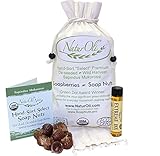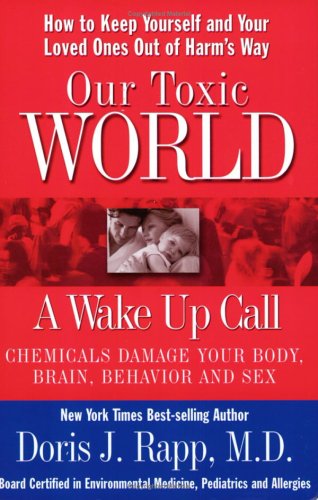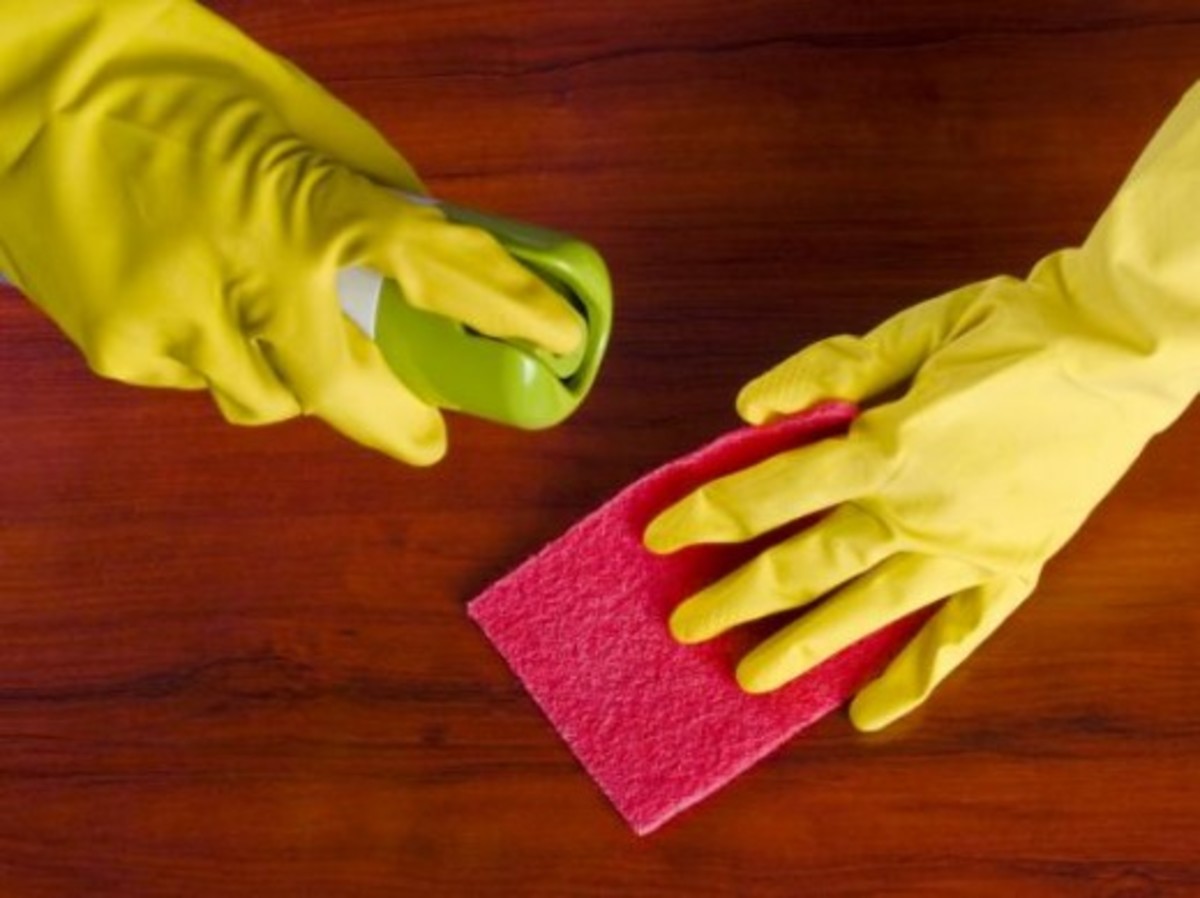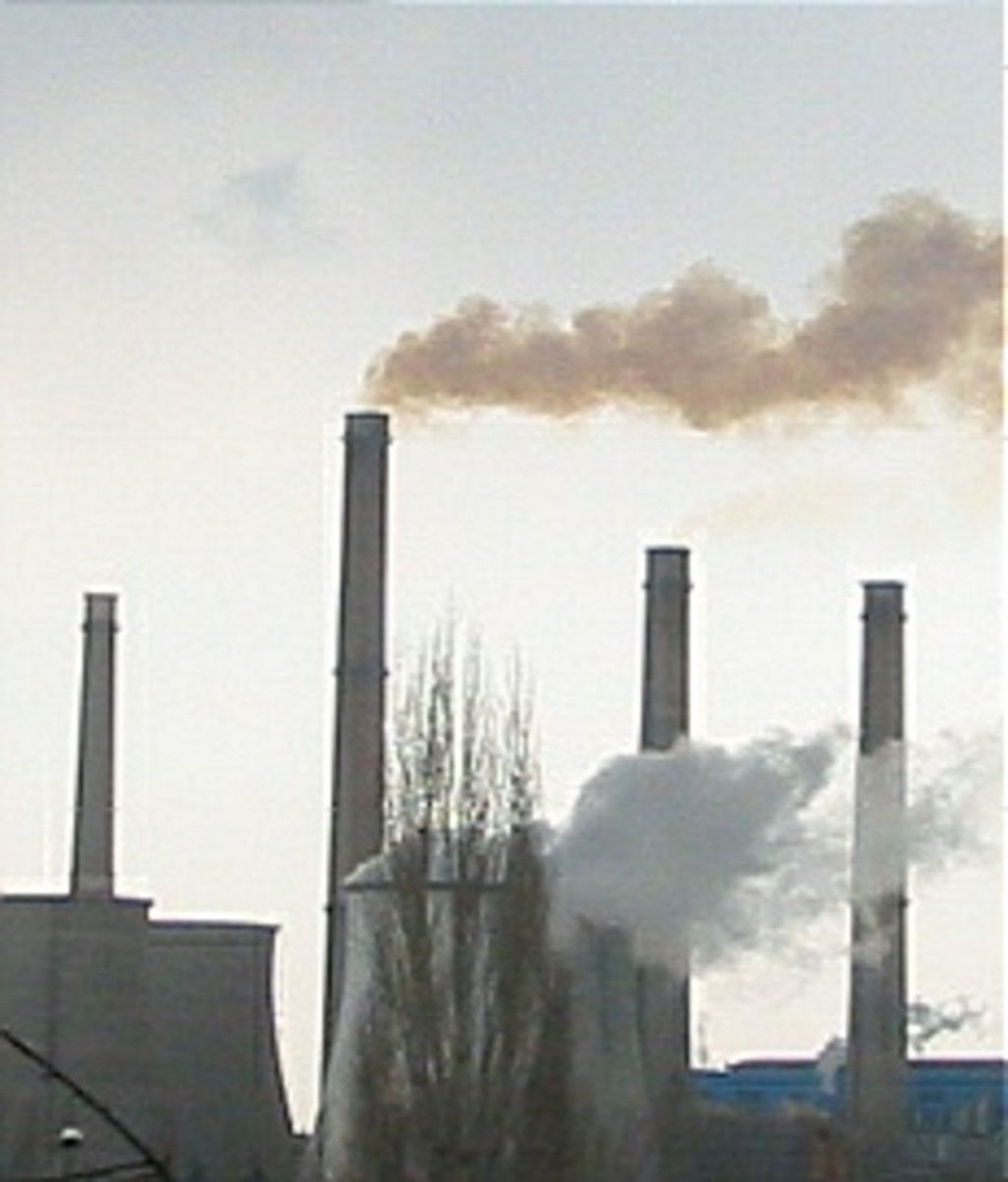Baby and Child Safe Cleaning

Home should be a safe place. Is yours?
Cleaning products containing toxic chemicals are linked with asthma, allergies, behavior problems in children, and cancer. Pregnant mothers and their babies are especially vulnerable.
"We are conducting a vast toxicologic experiment in our society, in which our children and our children's children are the experimental subjects." pediatrician Herbert L. Needleman.
Cleaning products often contain harmful chemicals that are not listed on the label. Only 1% of toxins are required to be listed on labels. This is mainly because the products don't make any claims about safety. Companies can also classify them as "trade secrets" to avoid listing them. Many of the ingredients labelled "inert" are actually more toxic than the active ingredients.
When considering cleaning products, they should be:
* Biodegradable
* Formulated without dye
* Nonflammable
* Contain no ammonia, acids, alkalis, solvents, phosphates, chlorine, nitrates, borates, or volatile organic compounds
If you have a poison emergency or a question about poisons and you're in the United States, call Poison Control at 1-800-222-1222"

What You Don't Want in Your Home
Some commonly used toxic substances...
Bleach: The chemical known as hypochlorite in bleach causes more poisoning exposures than any other household cleaning substance. May cause reproductive, endocrine, and immune system disorders. (Source: Annual Report of the American Association of Poison Control Centers' National Poisoning and Exposure Database (2005).) The main ingredient in chlorine bleach is sodium hypochlorite. Chlorine is toxic as a skin irritant, and by inhalation. Sodium hypochlorite can create poisonous chlorine gas if mixed with ammonia (which may be an unlabeled ingredient in some cleaning products) or with vinegar. Workplace safety data sheets warn that sodium hypochlorite may be a neurotoxin and cause liver damage. People with chemical sensitivies report adverse reactions to minute quantities of chlorine.
Phenol: Phenols are a major indoor pollutant. Phenols are absorbed by lungs, and skin. Symptoms include caustic burns, kidney and liver damage and hyperactivity. Do you use Lysol in your home? It contains phenol and dioxin (think Agent Orange).
Formaldehyde: Formaldehyde, an anticipated carcinogen, is a preservative found in many household products. People with asthma may be more sensitive to the effects of inhaled formaldehyde. Formaldehyde is also considered a "sensitizer," meaning repeated exposures can induce chemical sensitivities. Some experts believe that sensitizers like formaldehyde contribute to the development of multiple chemical sensitivity.
D-limonene - This chemical is produced by cold-pressing orange peels. The extracted oil is 90% d-limonene. It is a sensitizer, a moderate eye and skin irritant, and can trigger respiratory distress when vapours are inhaled by some sensitive individuals. D-limonene is the active ingredient in some insecticides. It is used as a solvent in many all-purpose cleaning products, especially 'citrus' and 'orange' cleaners. Also listed on labels as citrus oil and orange oil. Avoid this if you are chemically sensitive.
Ammonia: Exposure to high levels of ammonia in air may be irritating to your skin, eyes, throat, and lungs and cause coughing and burns. Asthma sufferers may be more sensitive to breathing ammonia than others. Getting ammonia into the eyes can cause burns and even blindness. (Sources: Agency for Toxic Substances and Disease Registry (2004); U.S. Department of Health and Human Services, Public Health Service.)
Nonylphenol ethoxylates (NPE's): Endocrine disrupters which mimic female hormones. This may be the cause of male fish in waterways morphing into females. They may also be implicated in the shifting of the human birth rates to favor girls.
Degreasers: Many degreasers contain petroleum distillates and butyl cellosolve; which can damage lung tissues and dissolve fatty tissue surrounding nerve cells.
What Do You Think?
Do you use safe cleaning products in your home?

What You Should Know About Your Laundry Detergent and Dryer Sheets
Many well-known laundry powders, like Tide, All,
Gain, and Dash, contain sodium silicate-a corrosive that can burn the eyes and skin. Other chemicals often found in laundry detergent are sodium sulfate (a corrosive that can cause severe eye, skin, and respiratory irritation), ethoxylated alcohols (which may contain I,4-dioxane, which is "reasonably anticipated" to be a human
carcinogen).
Laundry detergents also contain phosphorus, ammonia, naphthalene, phenol, sodium nitilotriacetate and countless other dangerous ingredients. These chemicals can cause rashes, itching, allergies, sinus problems and more. Of even greater concern is the residue left on your clothes, bed sheets, etc. that is absorbed through your skin. It is this absorptive ability that makes transdermal medication patches so effective. Why not use safe, natural laundry products on all your family's clothing and bedding?
Did you know that most dryer sheets give clothes a fragrance and reduce static using an oil film, which interferes with your ability to smell by coating your nasal passages. These chemicals can also be a serious problem for children or adults with asthma. Have you heard about the risk of fire from flammable dryer sheet residue? Test your dryer: Clean out the lint screen and try running hot water into it. Does it sit on top of the screen? This film coating the mesh can cause your dryer to overheat. Remove it with warm soapy water and a toothbrush.
If you are using a natural detergent, you might find that you can skip the dryer sheets. We find that we rarely need them. If you avoid synthetic fabrics you may also avoid much of the static buildup. Line drying is also a great alternative. Or try wool dryer balls if you can't or prefer not to line dry your clothes.
Natural Solutions for Laundry.

How to Remove Stains the Safe, Nontoxic Way
Because chlorine bleach is harmful to your health and even weakens the fibers of your clothing, it is imperative to use safe products to whiten clothing and remove stains. Oxygen based cleaners might be a good choice. Castille soap can work really well as a pre-treater for stains. Blood can be removed with peroxide in most cases. (Always check color fastness of fabrics in an inconspicuous area on the garment first.) Whites can be "bleached" by handing them out in the sun. Some say placing whites on (clean) grass in the sunshine works even better. For more ideas check here.
Or try your hand at making this homemade "bleach".

Beware of Toxic Chemicals in the Kitchen
Many automatic dishwasher detergents contain dry chlorine that is activated when it encounters water in the dishwasher. Chlorine fumes are released in the steam that leaks out of the dishwasher. Harmful effects are intensified when chlorine is exposed to heat.
Cascade and Sun Light, two of the best-selling
brands of automatic dishwashing detergent, contain phosphates. Phosphates released into the environment rob lakes and ponds of oxygen, leading to the suffocation of aquatic plants and animals.
Have you noticed that many dishwashing liquids are labelled "harmful if swallowed"? Most contain Naphtha, a CNS depressant, diethanolsamine, a liver poison, and/or chlorophenylphenol, a toxic metabolic stimulant. Ethoxylated alcohols in liquid detergents can also contain carcinogenic 1,4-dioxane. I urge you not to use these toxic products on the dishes your family eats off of.
Do your hands get irritated when you wash dishes? Some dishwashing liquids use petroleum-based surfactants, containing detergents such as diethanolamine (DEA) and sodium dodecylbenzensulfonate. Both ingredients can be skin and eye irritants.
Oven Cleaners: One of the most dangerous cleaning products, oven cleaners can cause severe damage to eyes, skin, mouth and throat. (Source: U.S. Department of Health and Human Services, Agency for Toxic Substances & Disease Registry.) The active ingredient in many oven cleaners is sodium hydroxide, which is very corrosive and can cause severe burns in all tissues that come in contact with it. Sodium hydroxide is odorless; thus, odor provides no warning of hazardous concentrations. Inhalation of sodium hydroxide is immediately irritating to the respiratory tract. Swelling or spasms of the larynx leading to upper-airway obstruction and asphyxia can occur after high-dose inhalation. Inflammation of the lungs and an accumulation of fluid in the lungs may also occur. Ingestion of solid or liquid forms of sodium hydroxide can cause spontaneous vomiting, chest and abdominal pain, and difficulty swallowing. In the case of accidental ingestion, corrosive injury to the mouth, throat, esophagus, and stomach is very rapid and may result in perforation, hemorrhage, and narrowing of the gastrointestinal tract. Cancer of the esophagus has been reported 15 to 40 years after the formation of corrosion-induced strictures. Skin contact with sodium hydroxide can cause severe burns with deep ulcerations. Long-term exposure to sodium hydroxide in the air may lead to ulceration of the nasal passages and chronic skin irritation. Sodium hydroxide contact with the eye may produce pain and irritation, and in severe cases, clouding of the eye and blindness.

Safe Ways to Soften Laundry
Other ways to freshen clothes and reduce static
You are more likely to have static build up in your clothing because chemicals from laundry soap create it. (How convenient for the manufacturers!) It may take several washings with chemical free detergents to eliminate the chemical residue static. Your patience will be well rewarded, and you may find that you do not need dryer sheets or fabric softener at all.
Add vinegar to the rinse cycle. This will freshen and soften clothes. If you cannot monitor the machine to add the vinegar, try filling a fabric softener dispenser ball about halfway. These are plastic balls designed to release fabric softener during the rinse cycle. They open automatically during the spin cycle right after the wash.
Hang clothes to dry outside in the sun. This is great for the environment and will save you money on your electric or gas bill. Line drying eliminates static. Vinegar in the rinse will help prevent line dried clothes from feeling stiff.
Line dry synthetic fabrics, such as polyester. You can even hang your synthetic fleeces up to dry indoors during the winter. It air-dries very quickly without wrinkling, leaving your other laundry in the dryer static-free.

Are Dryer Balls Safe?
What is in Plastic Fabric Softener Dryer Balls?
Plastic dryer balls are made of polyvinyl chloride, one of the least recycleable types of plastic. The manufacture and incineration of these supposedly "earth-friendly" softeners releases carcinogenic dioxins. In addition, toxic phthalates
are frequently used to make this type of vinyl soft and flexible. These plastic balls, which resemble teething toys, present a risk to young children who might be tempted to put them in their mouths.
Try wool dryer balls instead. A much safer and more environmentally friendly choice.
Safe and Natural

Looking for something safer to clean the toilet and disinfect surfaces?
Disinfectants are usually phenol- or cresol-based and deactivate sensory nerve endings. They attack the liver, kidneys,spleen, pancreas, and the central nervous system (CNS) and it takes over a year to eliminate the unhealthy effects of spraying 2 ounces, even with heavy cross ventilation.
There is some debate about whether or not we should use germicides, antibacterial soaps, etc. but this is a matter of personal choice. Some authorities feel that exposure to germs is beneficial to the development of the immune system and that excessive use of these products can lead to the development of "superbugs". I personally like to disinfect my bathrooms occasionally, especially as a mother of two boys. Try using vinegar and hydrogen peroxide, each in a separate bottle. First spray one bottle, and then the other over the same area (do not combine in the same bottle), then wipe clean.

What About Bleach?
The Chlorine Conundrum
by Carmela M. Federico
Chlorine bleach has long been a home care staple, used for disinfecting and restoring bright luster to dingy clothes. But be warned: that over-the-counter bleach bottle can contain a caustic poison, which can profoundly irritate eyes, noses, throats and lungs. Like an evil genie, it can be potently harmful when it leaves its bottle.
Some very damaging substances-dioxins and furans, for example, and also trihalomethanes-can arise when chlorine products come in contact with organic matter such as wood, soil, waste, etc. Dioxins and furans can form when chlorine atoms react with wood pulp, as is the case in the paper bleaching process, or when municipal waste or backyard garbage is burned but not thoroughly. Dioxins and furans are extremely toxic chemicals, known carcinogens and hormone distruptors, and are among the "dirty dozen" chemicals targeted for elimination in the 2001 Convention on Persistent Organic Pollutants. Trihalomethanes-including the carcinogen chloroform-are formed when chlorine reacts with carbon-containing organic matter. Some studies suggest that trihalomethanes may cause miscarriages, birth defects, and bladder and rectal cancers.
The news about household bleach isn't all bad: it is a relatively weak solution of sodium hypochlorite or sodium hydroxide, a chlorine compound. Household chlorine bleach breaks down quickly in the environment to release salt, oxygen, water and chlorine. Chlorine is an abundant element (it is a major constituent of salt, for example) and does not bioaccumulate, so there isn't a risk of gradual buildup in one's body over years to a toxic dose.
Unfortunately, household bleach usually contains trace amounts of hazardous organochlorine compounds, particularly in scented varieties, according to Philip Dickey, Ph.D., staff scientist with Washington Toxics Coalition, and tiny amounts are further produced as it breaks down. Martin Wolf, Director of Product Quality and Technology at Seventh Generation, says that chlorine from bleach could produce dioxins, dioxin-precursors, and bioaccumulating chlorophenols from contact with humus in the waterways. Also, both he and Dickey note that small amounts of trihalomethanes can be produced as well, since they can form whenever chlorine encounters common sources of carbon such as dirt, sewage, or leaves in the water stream.
Household bleach poses a greater threat to health through carelessness or misuse. According to the EPA, in the year 2000 alone more than 25,000 children were exposed to or poisoned by household chlorine bleach. Moreover, if chlorine is combined with ammonia or with cleaners that contain acids (like toilet bowl or oven cleaners), toxic and highly irritating chloramine and chlorine gases can be produced-so take care in using bleach in combination with other products.
Source: The Green Guide

Baby and Child Safe Carpet Cleaning
Carpet Cleaners
Carpet cleaners can be extremely toxic to children; who tend to play and crawl around on carpets. Carpet and upholstery cleaners accounted for 5397 poison exposures in 2005. The majority of these involved children under six. The bottom line for me, children are more important than the carpet. If you can avoid having carpets in your home, It is probably the healthiest approach all around. If not, spot cleaning with safe products is a good approach. Try using steam to remove stains as well, you might be surprised at how well it works.
Cleaning with Steam
Is Scotch Guard Safe?
SO WHAT ARE PFCs AND WHY SHOULD I CARE?
1. What are PFCs? - Perflurochemicals (PFCs) are used in famous brands such as Teflon, Stainmaster, and Scotchguard. These products support our lifestyle by providing nonstick cookware, and protection against stains. They are found in pans, furniture, cosmetics, household cleaners, clothing and packaged food containers. The PFC industry is a multi-billion industry, and at first PFCs were thought to be biologically inert. OOPS! They aren't, and the Environmental Working Group (EWG) prepared a report on PFCs http://www.ewg.org/research/pfcs-global-contaminants/pfc-health-concerns that was based on 50,000 pages of regulatory studies and FDA documents, as well as internal documents from DuPont and 3M.
Note: our government has not required manufacturers to monitor or report emissions of PFCs or its family members.
2. Can PFCs really damage my health?
- The report documents that observed blood level of PFCs in the population overlap levels that laboratory studies have shown to have harmful effects
- 3 of 4 types of tumors caused by PFOA (a member of the PFC family) are on the rise. The 4 types are testicular, breast, liver and prostate. PFOA also causes hypothyroidism. We all know people with these kinds of cancers and with low thyroid function.
- in an FDA risk study with rats, that was sponsored by 3M, rats exposed to low doses of PFCs showed decreased growth of the pituitary gland.
- The EPA classifies PFOA as carcinogenic in animals causing testicular, pancreatic, mammary and liver tumors in rats.
- Human workers at the manufacturers have elevated risk of dying from or seeking treatment for cancers of the pancreas and male reproductive tract. Mortality studies of 3M workers at one plant found that chemical division workers with 10 of more years at the plant were 3.3 times more likely to die of prostate cancer.
- So far five different pathways have been identified that might explain how PFO causes cancer and other types of toxicity.
3. Will PFCs biodegrade in a reasonable time?
- In 1972 a National Academy of Science report stated that, "these chemicals are likely to persist in the environment for extended periods unaltered by microbial catabolism,"
- A 1978 report by 3M stated that FPOA was "completely resistant to biodegration." 3M also indicated that their, "wonder chemicals," were more persistent than DDT, PCBs and Dieldrin.
4. Are PFCs pervasive?
- PFCs are widely found in meats and produce.
- PFCs have been found in tap water, food, rivers and lakes, wastewater treatment and landfill in many locations
- In a 3M study in 2001, 598 children from 23 states were tested, and 96% had PFOA in their blood.
There is a lot more in the report, but a hope that we can agree the PFCs are present, harmful and will be around for many years. Our grandchildren and great grandchildren may pay a health price for our 20th and 21ast century life style. How much more will we be increasing that price?
(Excerpt from a newsletter by S. & A. Abrams, 2003.)

Hazardous Chemicals in the Bathroom
Think about the following as you read: If you were using these types of chemicals in an industrial workplace, what precautions would OSHA require? Gloves? Goggles? Respirator? Do you use these when you clean the bathroom?
Toilet Bowl Cleaners: One of the most dangerous cleaning products, toilet bowl cleaners can contain chlorine and hydrochloric acid. Harmful just from inhalation. Toilet Bowl Cleaners accounted for 10,461 poison exposures in 2005. (Source: Annual Report of the American Association of Poison Control Centers' National Poisoning and Exposure Database) (2005).
Hydrochloride/ Hydrochloric Acid (HCl): Contained in some toilet bowl cleaners, HCl can cause severe damage to skin and eyes. Some people exposed to HCl may develop an inflammatory reaction called reactive airways dysfunction syndrome (RADS), a type of asthma caused by some irritating or corrosive substances. Swallowing HCl causes severe corrosive injury to the lips, mouth, throat, esophagus, and stomach. (Sources: Agency for Toxic Substances and Disease Registry (2007). Managing Hazardous Materials Incidents. Volume III, Medica)
Scouring Powders: Many traditional scouring cleansers, like AJAX powder, contain crystalline silica, an eye, skin, and lung irritant, classified as "reasonably anticipated to be a human carcinogen" by the National Institute of Environmental Health Sciences. Some scouring cleaners may contain sodium hydroxide or bleach that can irritate mucous membranes and cause liver and kidney damage.
Limescale removers: Many limescale removers contain sulfamic acid, which is toxic to lungs and mucous membranes. Direct skin contact with sulfamic acid is corrosive and causes irritation, dryness or burning. Eye contact can result in corneal damage or blindness. Inhalation of sulfamic acid will produce irritation to gastro-intestinal or respiratory tract with burning, sneezing or coughing. Severe over exposure of sulfamic acid can produce lung damage, choking, unconsciousness or death.
A person who spends 15 minutes cleaning scale off shower walls could inhale three times the "acute one-hour exposure limit" for glycol-ether containing products set by the California Office of Environmental Health Hazard Assessment. Sources: News-Medical.Net; University of California at Berkeley.

Are Dryer Sheets and Fabric Softener Making You Sick? What to Do:
By Julia Kendall. Edited for length, full content available on request.
Chemicals found in fabric softeners by U.S. Environmental Protection Agency
-Alpha-Terpineol
-Benzyl Acetate
-Benzyl Alcohol
-Camphor
-Chloroform
-Ethyl Acetate
-Limonene
-Linalool
-Pentane
Exposure can result from the outgassing of vented dryers or from treated fabrics (e.g., clothes, sheets, towels), which are in close proximity to you. Questions to ponder:
Have you been enjoying a walk in the neighborhood and found you have suddenly fallen without realizing why?
Do you get a numb feeling in the side of your face -- and the doctors can't find the reason?
Do you get a sudden onset of dizziness or a headache?
Fabric softeners, like other fragrant products, contain petrochemicals, used in untested combination. These chemicals can adversely affect the central nervous system (CNS) -- your brain and spine.
CNS exposure symptoms include: aphasia, blurred vision, disorientation, dizziness, headaches, hunger, memory loss, numbness in face, pain in
neck and spine. CNS disorders include: Alzheimer's Disease, Attention Deficit Disorder, Dementia, Multiple Chemical Sensitivity, Multiple Sclerosis,
Parkinson's Disease, Seizures, Strokes, Sudden Infant Death Syndrome (SIDS).
If you use fabric softeners (liquid or sheets), STOP! Save the container as evidence -- doctors can request analysis. If made ill by fabric softener used by another person, give product name if known. Write down a description of your symptoms. Take it to your doctor to help document your symptoms. Act Now. If you are ill from fabric softeners:
Telephone 1-800-638-2772; press 1; press 999 -- to file an official complaint with the U.S. Consumer Product Safety Commission. Say you want to file a report on a hazardous product. Emphasize central nervous system disorder symptoms. Allergic symptoms are not given priority in Commission investigations. Demand a recall. Please have everyone you know who reacts to fabric softeners call. The tally will be useful in litigation and publicity.
Telephone 1-800-543-1745 -- Proctor and Gamble (Downy & Bounce); 1-800-598-5005 -- Lever Bros. (Snuggle); or, contact the manufacturer of the
product you know makes you ill.
Call the Air Quality Management and the Air Resources agencies in your area. File a complaint. Ask for information regarding their policies for presenting issues to their boards. Request the boards consider the issue of scented fabric softeners in dryer exhaust as outdoor air pollution.
Resources for Further Research
- National Institutes of Health Household Products Database
Have I missed anything? Look up Toxicity Information or Health Information for the chemical or brand name here. - Agency for Toxic Substances and Disease Registry: ToxFAQ's
Toxicological profiles on hazardous substances by chemical name. A very nice resource. - Story of Stuff
Learn about how the products we use in our homes, big and small, affect the environment and our health. - Healthier Food Use of Plastics for Parents and Children
Institute for Agriculture and Trade Policy, Food and Health Program: Smart Plastics Guide - Healthy Child Healthy World
Our favorite company has partnered with Healthy Child Healthy World to help raise awareness of the health issues we all face and provide education about the simple, wise choices everyone can make to create a cleaner, greener, and safer home and plane - Where to Recycle
A list of resources to recycle all sorts of items, large and small.
Body Pollution
Resources for Further Reading
This work is licensed under a
Creative Commons Attribution-Noncommercial-No Derivative Works 3.0 United States License.



















